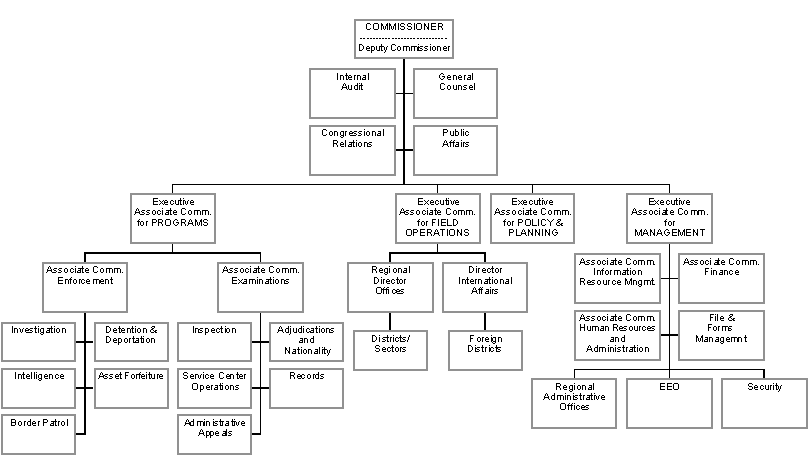
Figure 1
IMMIGRATION AND NATURALIZATION SERVICE
ANNUAL FINANCIAL STATEMENT
FISCAL YEAR 1996
Audit Report 97-22A, (8/97)
TABLE OF CONTENTS
OFFICE OF THE INSPECTOR GENERAL COMMENTARY AND SUMMARY
INDEPENDENT AUDITOR'S REPORT ON THE FINANCIAL STATEMENT
INDEPENDENT AUDITOR'S REPORT ON INTERNAL CONTROL STRUCTURE
INDEPENDENT AUDITOR'S REPORT ON COMPLIANCE WITH LAWS AND REGULATIONS
COMBINED PRINCIPAL FINANCIAL STATEMENTS:
COMBINING PRINCIPAL FINANCIAL STATEMENTS:
NOTES TO COMBINED FINANCIAL STATEMENTS
APPENDIX I - AUDIT DIVISION ANALYSIS AND SUMMARY OF ACTIONS NECESSARY TO CLOSE THE REPORT
OFFICE OF THE INSPECTOR GENERAL
COMMENTARY AND SUMMARY
This audit report contains the Annual Financial Statement of the Immigration and Naturalization Service (INS) for the fiscal year ended September 30, 1996. The report includes INS management's overview, the principal financial statements and related notes, and the independent auditor's reports on the principal financial statement, internal control structure, and compliance with laws and regulations. The annual financial statement is the responsibility of the INS management. This audit was performed as part of the Department of Justice's (DOJ) effort to implement the Government Management Reform Act of 1994 (GMRA), which requires an annual financial statement audit of the DOJ beginning with FY 1996. The results of the annual financial statement audit of the INS as presented in this report will be relied upon by Price Waterhouse LLP in its performance of the consolidated financial statement audit of the DOJ, which will be issued as a separate report by the Office of the Inspector General (OIG).
The OIG contracted with Urbach Kahn & Werlin PC, Certified Public Accountants, to perform the FY 1996 audit of the INS combined Statement of Financial Position. The audit was conducted in accordance with generally accepted government auditing standards and Office of Management and Budget Bulletin No. 93-06, "Audit Requirements for Federal Financial Statements." The OIG performs an oversight role in the audit process and ensures compliance with the GMRA by monitoring the progress of the audit, reviewing supporting workpapers, coordinating the issuance of reports, and following up on findings and management letter issues.
As part of the DOJ-wide audit, Price Waterhouse LLP performed a general controls review of the Justice Data Centers that process INS' data. The results of this work were considered by Urbach Kahn & Werlin PC in performing its audit of the INS. Additional work was performed by Urbach Kahn & Werlin PC at INS, as considered necessary to complete the audit.
Reporting Entity
The INS was established by the Immigration and Nationality Act (INA), as amended, which charges the Attorney General with the administration and enforcement of its provisions and other laws relating to the immigration and naturalization of noncitizens. The mission of the INS is to determine the admissibility of persons seeking entry and to adjust the status of and provide other benefits to legally entitled noncitizens. This includes assistance to those who seek permanent resident status and those who wish to become citizens through naturalization.
For FY 1996, INS employed over 25,000 persons and its budget was approximately $2.6 billion.
Audit Results
The audit resulted in a disclaimer of opinion on the combined Statement of Financial Position. The independent auditor was unable to substantiate a significant portion of account balances because INS did not maintain appropriate accounting records and relevant documentation. The independent auditor was unable to apply audit procedures sufficiently to determine the extent to which the combined Statement of Financial Position may have been affected by these conditions. As a result, the scope of the independent auditor's work was not sufficient for the auditor to express an opinion.
The independent auditor determined that INS did not have an adequate internal control structure and its report on the internal control structure identified seven material weaknesses with respect to: (1) INS' overall control environment, (2) supporting documentation, (3) fund balance with Treasury reconciliation process, (4) fixed assets, (5) accounts payable, (6) recording of revenues and expenses, and (7) INS' financial management systems. In its report on compliance with laws and regulations, the independent auditor did not concur with INS' assessment that its system of internal accounting and administrative controls and accounting systems, notwithstanding the exceptions noted, taken as a whole comply with the Federal Managers' Financial Integrity Act (FMFIA).
Other conditions involving the internal control structure and compliance with laws and regulations were noted by the independent auditor and will be communicated, under separate letter, to management. The independent auditor was not contracted to perform control testing sufficient to enable the auditor to express an opinion on management's assertions over the effectiveness of the internal control structure or compliance with laws and regulations. Accordingly, the independent auditor did not express such opinions.
Financial and Other Operating Highlights
The INS expenses for FY 1996 totaled $2.3 billion. Approximately $1.3 billion (56 percent) was expended on Personnel Services and Benefits and approximately $460 million (20 percent) was expended on Contractual Services. The non-appropriated fee accounts contributed revenues of $944 million, or approximately 40 percent of Total Revenues and Financing Sources of $2.4 billion.
Longstanding financial management weaknesses have existed at INS through FY 1996. Annual financial statement audits of the INS Fee Accounts for FY 1991 through FY 1993, of the INS Breached Bond Detention Fund for FY 1993, and of INS' portion of the Violent Crime Reduction Trust Fund for FY 1995 resulted in disclaimers of opinion because of scope limitations. Specifically, the status of INS' accounting records precluded the independent auditors from performing audit procedures necessary to express an opinion. In addition, significant weaknesses in the internal control structure were also identified in corresponding reports on internal controls and compliance with laws and regulations.
In response to our auditors' reports on these audits, INS developed a corrective action plan designed to improve overall financial management and eliminate the weaknesses identified in the audit reports. The OIG issued two reports on the status of INS' corrective action plan as of September 30, 1995 (Report No. 96-04), and as of June 30, 1996 (Report No. 96-22). These status reports concluded that INS was making limited progress towards implementing its corrective action plan in a timely manner.
INS is also in the process of replacing its financial management system through a cross-servicing agreement with the Department of the Treasury, Financial Management Service. INS' goal is to have the core system operational by October 1, 1997.
MANAGEMENT'S OVERVIEW TO THE
FINANCIAL STATEMENTS
Fiscal Year 1996
MISSION AND ORGANIZATION
The Immigration and Naturalization Service (INS), an agency of the Department of Justice, was established by the Immigration and Nationality Act (INA), as amended, which charges the Attorney General with the administration and enforcement of its provisions and other laws relating to the immigration and naturalization of noncitizens. The Attorney General has delegated authority to the Commissioner of the INS to carry out national policy which provides for selective immigration and for controlled entry and stay of nonimmigrants in order to promote the reunification of families, entry of immigrants possessing needed skills, temporary admission of specific classes of noncitizens, and refuge from persecution.
The mission of the Service is to determine the admissibility of persons seeking entry and to adjust the status of and provide other benefits to legally entitled noncitizens within the country with proper regard for equity and due process. This includes assistance to those who seek permanent resident status and those who wish to become citizens through naturalization.
It is the responsibility of the Service to ensure appropriate documentation of aliens at entry, to deny entry to those who are not legally admissible whether they attempt to enter through ports-of-entry or surreptitiously across the border, and to determine the status of those in the country. The Service is also responsible for deterring illegal entry and stay, including enforcement of criminal provisions against those who act or conspire to promote such entry and stay. Further, it is the responsibility of the Service to detect, apprehend, and remove those noncitizens whose entry was illegal, whether undocumented or fraudulent, and those found to have violated the conditions of their stay.
The structure of INS is functionally divided into policy, management, and operations,
with operations further subdivided into programs and field operations. Programs include
both enforcement and examination activities. Field operations contain regional offices and
international affairs. Policy encompasses both planning and policy functions. Management
covers information resources, finance, human resources, administration, equal employment
opportunity, security, and records management. Overall, policy and executive direction
flows from Washington, D.C., headquarters to 3 regions, 33 districts and 21 border patrol
sectors throughout the United States in additions to 3 district offices overseas. The
three regional offices provide operational, policy and administrative support to the field
offices. The INS field offices provide direct service to applicants for benefits under INA
and carry out statutory enforcement

Figure 1
responsibilities in their respective geographic areas. They are also accountable to Field
Operations for implementing INS policies and participating in processes for budgeting,
personnel selection, and resource allocation. INS maintains three overseas district
offices in Bangkok, Thailand; Mexico City, Mexico; and Rome, Italy. Overseas offices serve
as important information channels between INS and U.S. Foreign Service officers and
foreign government officials abroad.
BUDGETARY RESOURCES AND STAFFING
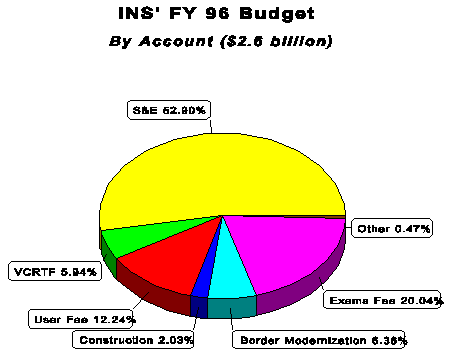
Figure 2
To support its mission, INS receives financial resources from the Salaries and Expenses
(S&E) appropriation, the Violent Crime Reduction Trust Fund (VCRTF), the Border
Control Modernization appropriation and the Border Construction appropriation (both also
established by the Violent Crime Act), and five non-appropriated accounts: the Immigration
User Fee account, the Immigration Examinations Fee account, the Immigration Legalization
Fee account, the Land Border Inspection Fee account, and the Breached Bond/Detention Fund.
During the past several years, the total INS budget has grown dramatically, due in
part to the creation of the violent crime reduction trust fund and the border
modernization and construction appropriations. The operating budget for INS reached $2
billion for the first time in FY 1995, including about $673 million from fees collected
for services. INS' operating budget in FY 1996, exceeded $2.6 billion, including $904
million from fees collected for services.
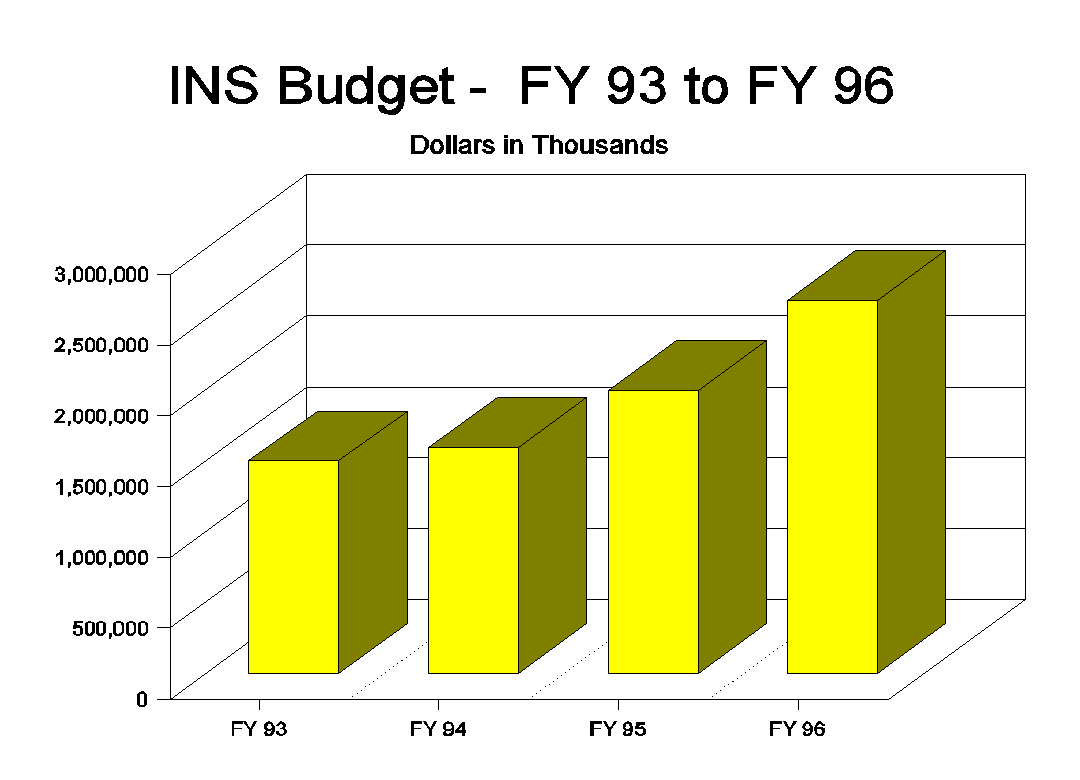
Figure 3
PRIORITIES AND ACCOMPLISHMENTS
To ensure that FY 1996 resources and efforts were directed in the areas of most concern to the President, the Congress, the Attorney General, and the nation, the Commissioner established annual performance goals, priorities and measures which were fed directly to its strategic plans. A synopsis of these priorities and high points of accomplishments for each in FY 1996 follows.
Professionalize the INS Workforce - targets recruitment, hiring, training, and supports work environment, equipment, and technology.
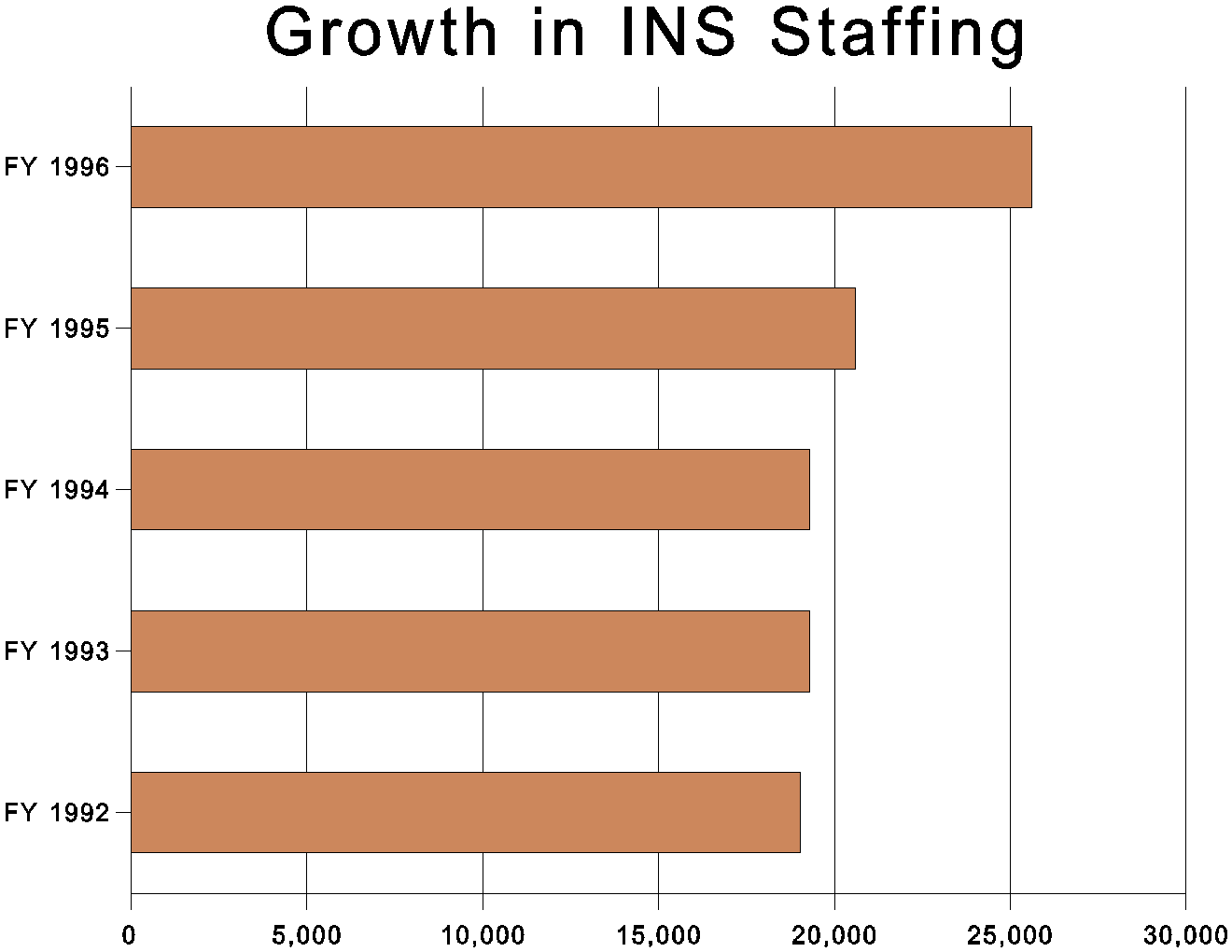
Figure 4
- INS employees increased by 5,000 in FY 1996 to 25,600 from 20,600 for FY 1995, with over
half of the new hires being minorities and/or women. INS achieved 94 percent of its
overall officer hiring goals for FY 1996 and filled 98 percent of training slots.
- INS used more focused advertising and targeted recruitment strategies which produced about 66,000 calls to the Telephone Application Processing System. More than 40,000 callers reported for written tests for Border Patrol and Immigration Officer positions, and about 9,500 passed the tests.
- During its first 6 months, the Charleston Satellite Training Facility trained 528
immigration inspectors (exceeding its goal of 525). Border Patrol training began at the
facility in August 1996.
- The Leadership Development Center began its first class on March 25, 1996 and has provided supervisory and management training to 861 students.
- The Security Program was successful in implementing the reinvented security screening process to complete security eligibility determinations within 25-35 days, a significant decrease from the 75-120 days experienced earlier.
Strengthen Border Enforcement and Facilitation - builds on INS' Border Control Strategic Plan for 1994 and Beyond, that supports and implements the paramount concept of "prevention through deterrence" at and between the Ports-of-Entry, and stresses flexible, effective and timely acquisition and deployment of personnel, technology, and equipment.
- Installation of an Automated Fingerprint Identification Subsystem (IDENT) enables INS to rapidly and accurately identify criminal aliens and illegal entrants. The IDENT was installed two months ahead of schedule with 129 terminals at 78 locations.
- The success of the dedicated commuter lane (DCL) at Otay Mesa, CA spurred Congress to extend the pilot program to five new sites on the southern border. The DCL enables residents of the border areas who cross frequently into the United States to submit an application for pre-screening. INS and the United States Customs Service must approve the application for low-risk, frequent border crossers. Once approved, a DCL windshield decal is provided for the applicant's vehicle. Participants in the DCL program bypass the formal inspection, but are subject to random compliance checks by INS.
- New INS Passenger Accelerated Service Systems (INSPASS) kiosks installed at New York, Newark, and Toronto airports reduced inspection times to less than 30 seconds for alien travelers and less than 15 seconds for INSPASS enrollees. INSPASS facilitates the integrity of the inspection process by utilizing a hand-geometry reader in order to validate a passenger's identity. This inspection system is used to monitor low-risk frequent travelers.
- Headquarters Intelligence received and evaluated 3,583 intelligence reports in FY 1996, more than any other year in recent history.
Increase Removal of Deportable Aliens - focuses on increasing the removal of illegal and noncompliant aliens, especially criminal aliens convicted of aggravated felonies, and non-criminal alien absconders, rejected asylees, and illegal workers.
- INS removed in FY 1996 a total of 67,094 aliens subject to a final order of deportation or exclusion, a 33 percent increase over FY 1995. Non-criminal removals were up 68 percent, and criminal removals increased by 15 percent.
Enhance Worksite Enforcement and Verification System - allows INS to work with the Department of Labor, certain targeted industries, and individual employers to enhance the worksite activities, document improvements, and provide automated status verification services--all efforts designed to reduce the opportunities for illegal employment.
- INS exceeded its objective for participating in 200 interagency enforcement operations by actually participating in 542 operations. This action surpassed the goal by 270 percent.
-INS removed over 16,000 illegal workers.
Improve Immigration Services - stresses INS' total commitment to the improvement of customer service and satisfaction through enhanced technology, increased staffing, training, and the development of various initiatives to ensure effective communication between INS service providers and their customers.
- The Telephone Support Operation pilot program enhanced "Ask Immigration" messages and reduced the number of most frequently requested telephone numbers to five. Survey results indicate 88 percent of respondents were satisfied with the service.
- The Secure Electronic Network for Traveler's Rapid Inspection (SENTRI) earned one of Vice President Gore's Hammer Awards (INS' 12th). In addition to this Hammer Award, INS was recognized for its contributions to two other reinvention efforts that received Hammer Awards - the Joint Automated Booking Station and the Justice Prisoner and Alien Transportation System.
Implement Naturalization Reengineering - commits INS to the goal of bringing naturalization processing current -- assuring the overall process from application filing to ceremony is completed within six months.
- INS exceeded the number of citizenship applications completed in FY 1995 by nearly 166 percent, from 505,913 in FY 1995 to 1,344,322 in FY 1996.
- Average processing time for naturalization decreased from 17.3 months in September 1995 to a national average of 6 months at the end of FY 1996.
Programs and Other Accomplishments: The following section presents a description of selected INS' Enforcement and Examinations programs along with additional highlights and accomplishments for each.
- The Border Patrol is responsible for maintaining control of U.S. borders by preventing illegal crossings by aliens between ports of entry. It is a highly mobile force of uniformed agents who spend much of their time patrolling the areas along the 8,000 miles of international boundaries in vehicles, aircraft, or boats, as well as on horseback or on foot. Overall apprehensions increased by 19 percent from 1,206,018 in FY 1995 to 1,437,104 in FY 1996. The time spent patrolling the border, conducting traffic checks, participating in anti-smuggling operations, and related activities increased by 14 percent from 8,033,364 border patrol hours in FY 1995 to 9,175,032 hours in FY 1996.
- Investigation efforts focus on enforcement of immigration laws within the interior of the United States. Plainclothes special agents use both traditional and innovative methods to investigate violations of immigration law and aliens involved in criminal activities, often participating in multi-agency task forces against narcotics trafficking, violent crime, document fraud, and traditional and nontraditional organized crime. Also, the agents monitor and inspect places of employment to apprehend unauthorized alien workers and to impose sanctions against employers who knowingly employ them. In FY 1996, INS Special Agents and Immigration Agents made over 98,000 arrests, a 43 percent increase over FY 1995.
- The Detention and Deportation (D&D) program detains, excludes, removes, paroles and deports aliens. Both INS and non-INS (contract) facilities are used to detain those aliens subject to deportation or exclusion proceedings who are likely to abscond or whose freedom at-large would clearly represent a danger to public safety. During FY 1996, INS increased D&D resources and achieved an increase of 17 percent (48,797) in deportation of aliens compared to FY 1995 (41,778).
- The Inspections program plays an integral role as the first point of contact for
travelers coming across the Mexican and Canadian land borders. In FY 1996, the total
number of persons inspected at land POE's totaled approximately 402.5 million. The total
number of persons inspected at air and sea POE's totaled 75 million. The total number of
inadmissible aliens for
FY 1996 was 1,019,957. Inadmissibles are aliens referred to secondary inspection who have
withdrawn, were refused entry or were referred to the Immigration Judge.
CRITICAL AREAS FOR FINANCIAL IMPROVEMENT
INS is extremely proud of its many accomplishments during the FY 1996, some of which are discussed in this overview. However, INS is also acutely aware of the need for continual improvement in the infrastructure necessary to support its growing organization and programs. Based on the difficulties encountered in providing financial services to its stakeholders and on the weaknesses and deficiencies identified in numerous audit reports related to financial systems, fees and property, INS has targeted these areas for an infusion of attention and resources in FY 1997. INS fully recognizes the need to upgrade and improve its financial systems through effective use of emerging technology and to adjust its financial management policies and procedures for maximum effectiveness and efficiency. Three areas where INS has begun to make notable progress and has an aggressive agenda for improvements in FY 1997 include:
Replacement Financial Management System: INS is proceeding in an effort to replace its financial management system. The current system is over 18 years old and does not have the functionality necessary for INS to efficiently manage and account for its resources. The current system has been the subject of material weaknesses in several Federal Managers' Financial Integrity Act (FMFIA) Management Control Reports, and has been identified by the General Accounting Office, the Department of Justice's Office of Inspector General, and INS internal auditors as the cause of numerous weaknesses and deficiencies in INS operations. INS and the Department have agreed to replace the aging INS financial system with a new financial management system. INS has identified technical system requirements for the new system and is proceeding with plans to acquire a new system. Implementation of critical functions of the new system is scheduled for October 1997.
Fee Setting Methodologies of User Fees for the Examination Fee Account: INS recognized certain limitations in its fee-setting methodologies, and pledged to improve its fee-setting techniques and methods. Accordingly, from July 1995 to November 1996, INS conducted a comprehensive review of the work processes and associated costs of immigration adjudication and naturalization activities. The work proceeded along two paths: (1) analyzing, classifying, and documenting application processing and taking statistically-valid measures of the time needed to complete identified work activities, and (2) creating a cost model while analyzing financial and budgetary records in an effort to assign costs to specific applications. INS developed a more consistent and reliable cost accounting methodology and produced a revised Examinations Fee Account Fee Schedule. Key components of this effort were the detailed review and identification of all costs related to adjudicating immigration and naturalization applications, and the logical assigning of these costs to the appropriate benefiting application. In the future, INS will migrate the above cost methodology to its other fee accounts, including the Immigration User Fee Account and the Breached Bond Detention Fund.
Implementation of an Asset Management System: In FY 1996, INS began implementation of selected modules (firearms, automated data processing equipment and vehicles) of its Asset Management Information System (AMIS) for certain INS offices. The system is designed to provide INS with managerial support and analysis capabilities, real time information and updates, and the overall means of achieving fiscal accountability for assets in accordance with applicable policies and procedures, including the Chief Financial Officers (CFO) Act of 1990. AMIS is designed to maintain and report data for the acquisition, disposition, relocation and depreciation of assets. INS plans to build an interface between AMIS with the new financial management system and to update the financial system with data from AMIS. Additional modules to be implemented in FY 1997 include aircraft, real property, and communications equipment.
INS is fully committed to improving its infrastructure as pertains to financial management and is proceeding on several fronts to work toward improving financial systems, improving financial reporting and accountability, enhancing the quality of financial services to stakeholders, and reengineering its financial practices and processes. Many of these efforts are in the infancy stages but INS has set a fast-paced correction course to achieve its goals. INS shares the view of the government-wide Chief Financial Officers Council that the key to improved financial and program management is improved financial management systems. Improving financial management systems will provide for and strengthen INS' decision-making capabilities and enable program and financial managers to more effectively carry out their missions.
Limitations of the Financial Statements
The Office of Management and Budget (OMB) requires that the following three statements be included to remind readers of the basis for financial statements prepared for federal government activities and the limitations inherent with the financial statements prepared for this report:
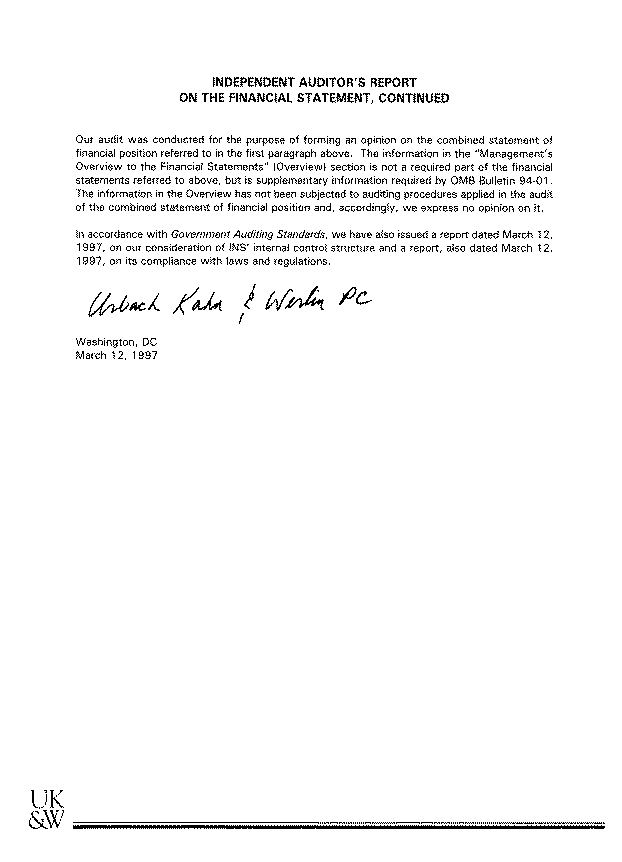
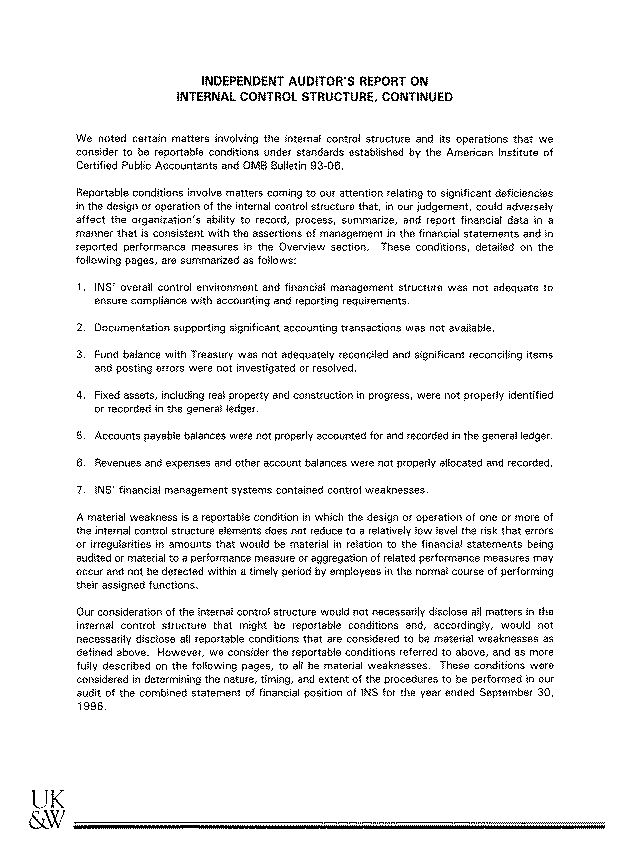
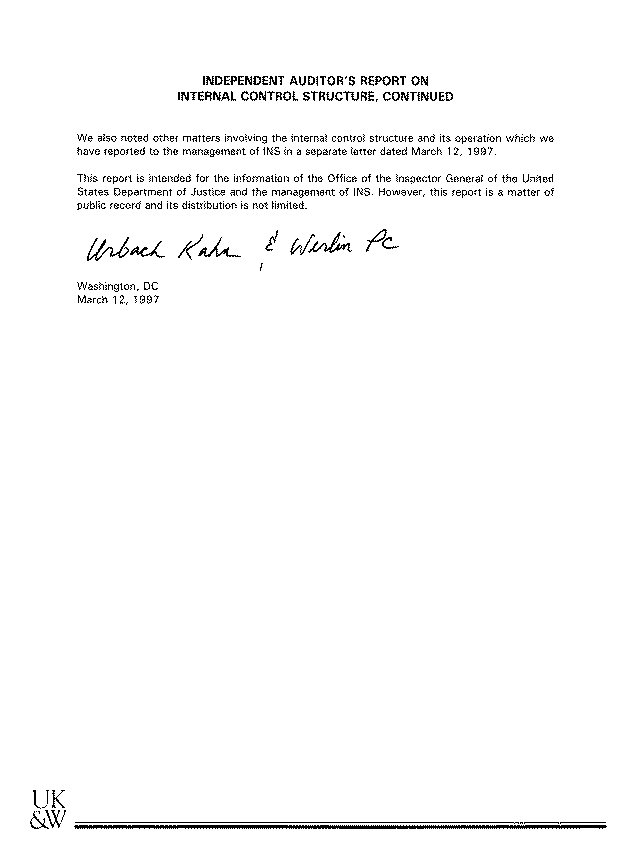
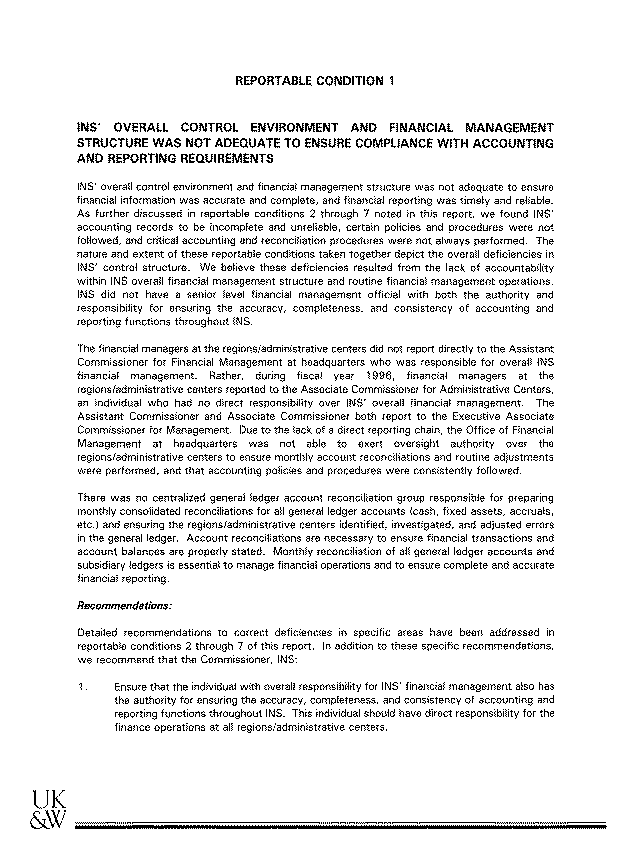
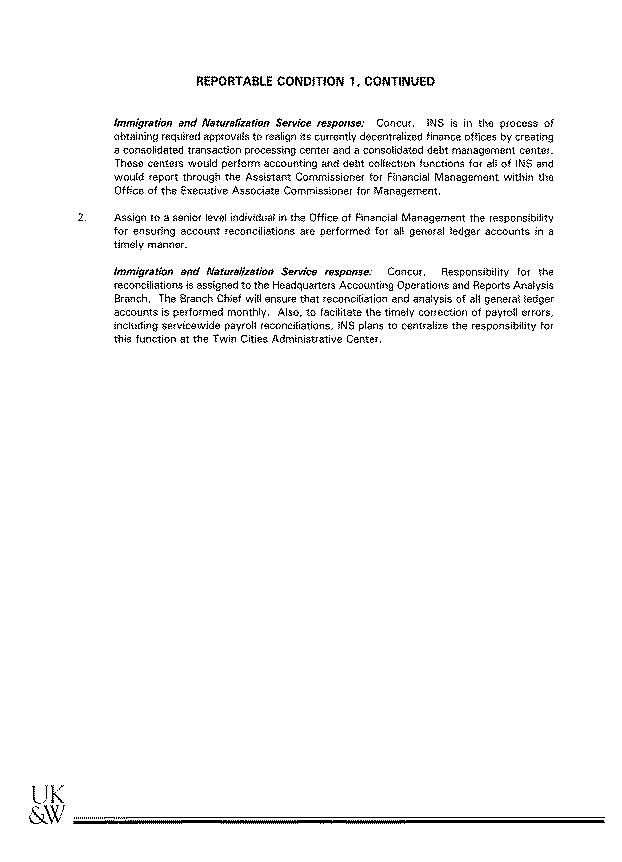
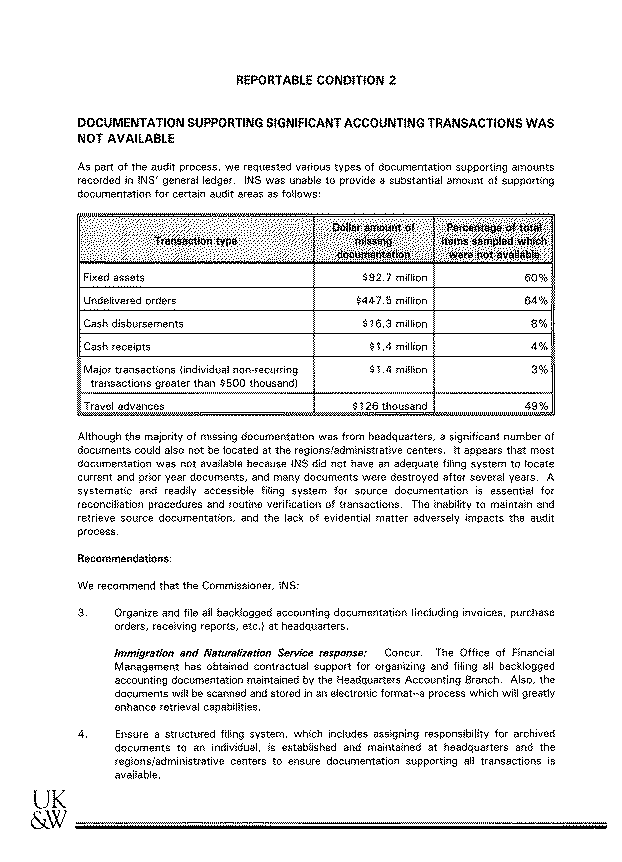
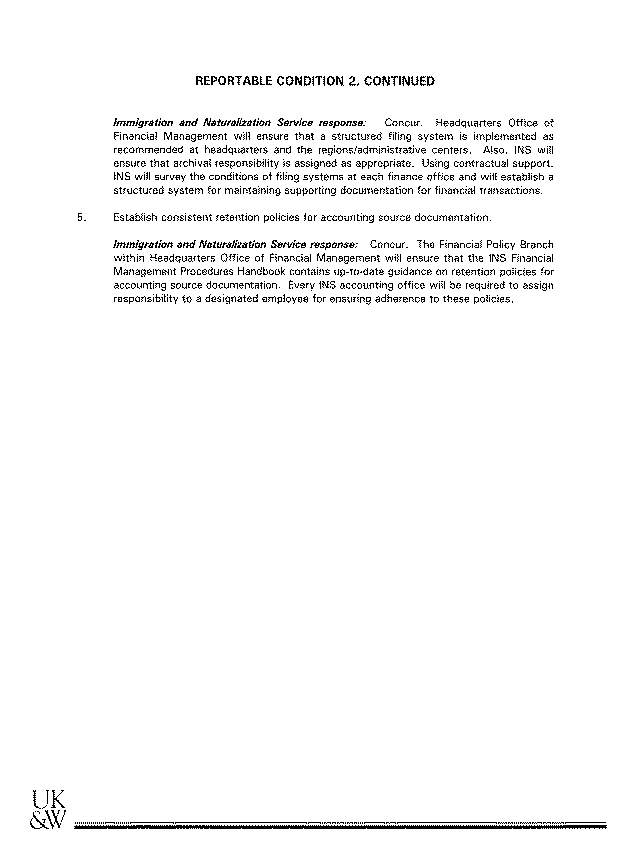
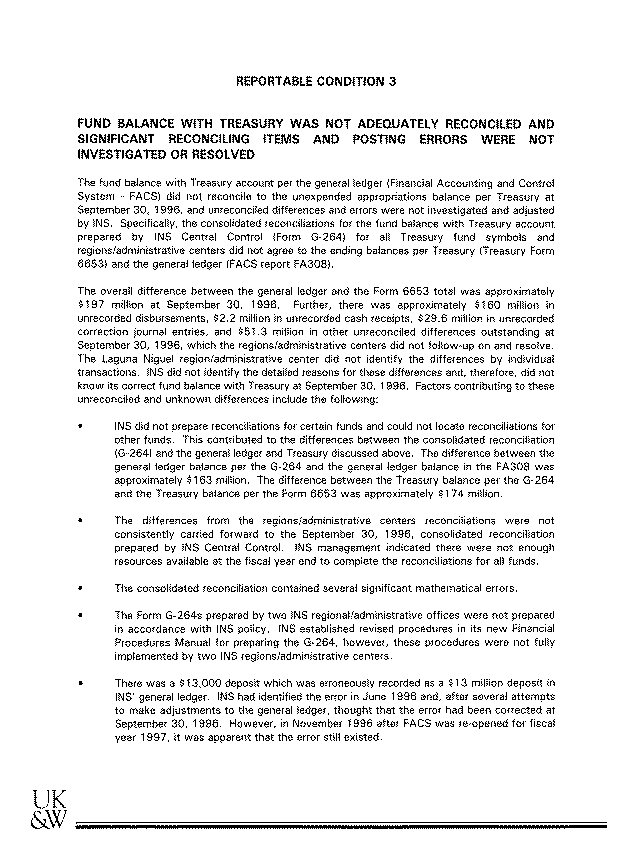
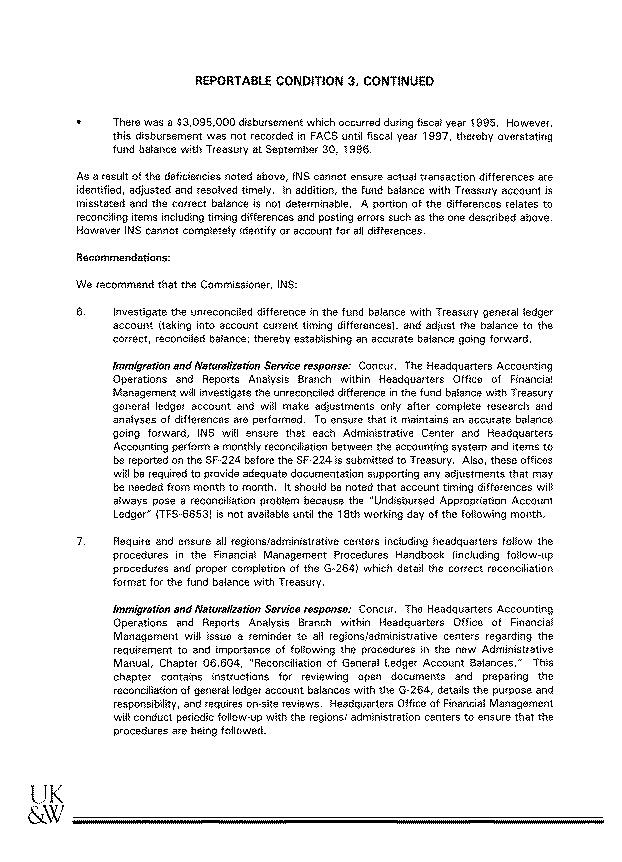
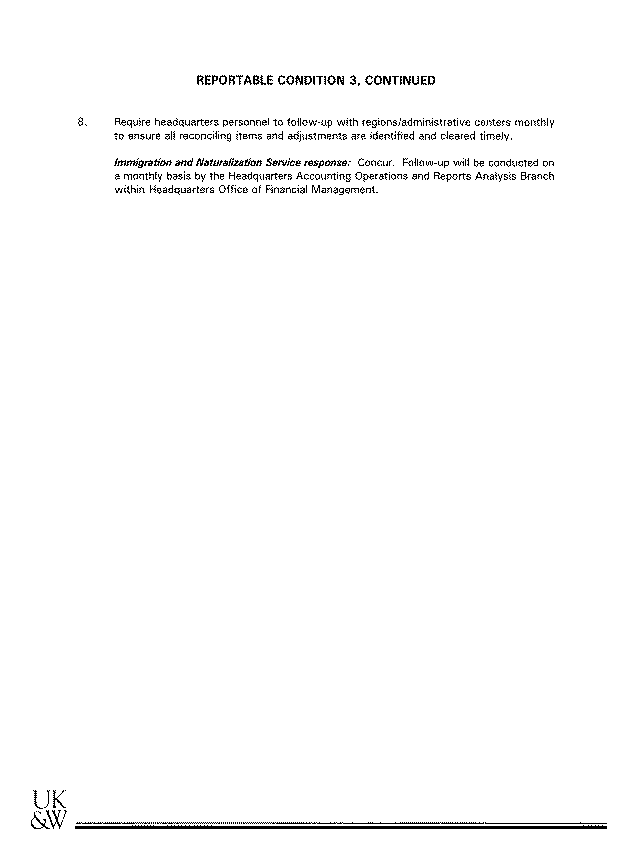
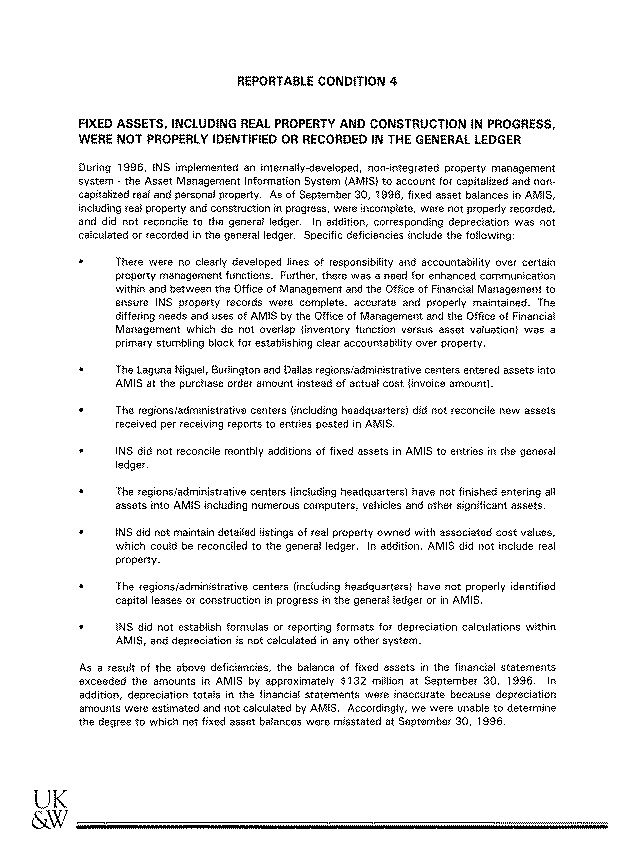
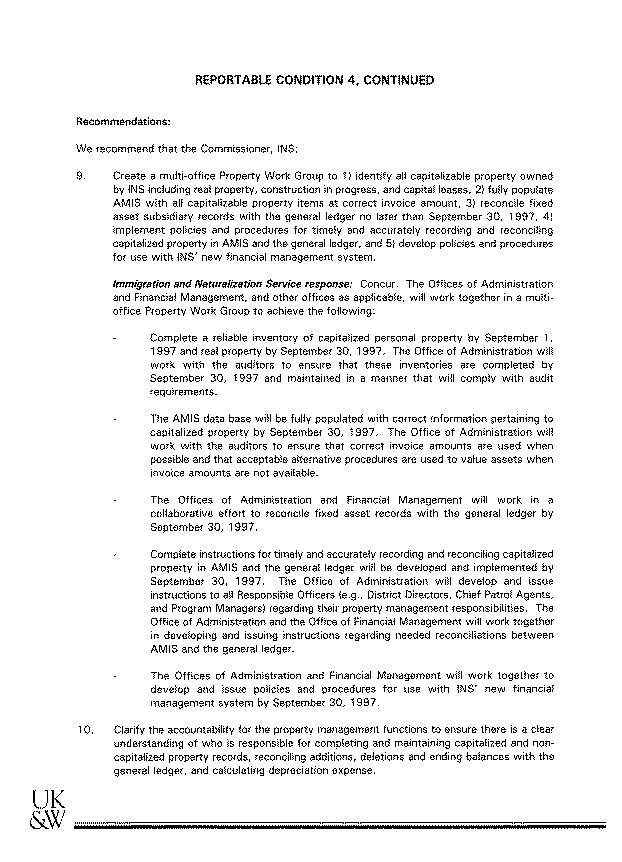
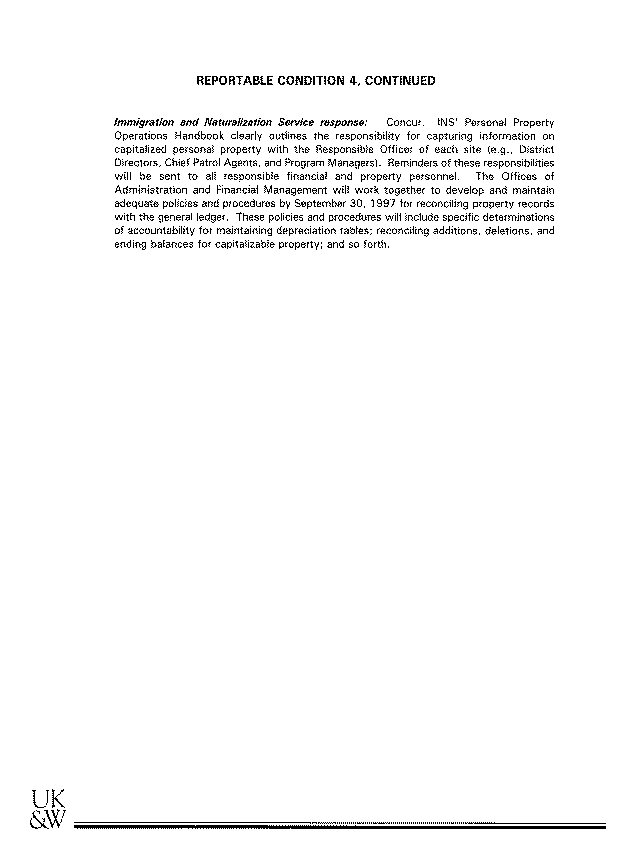
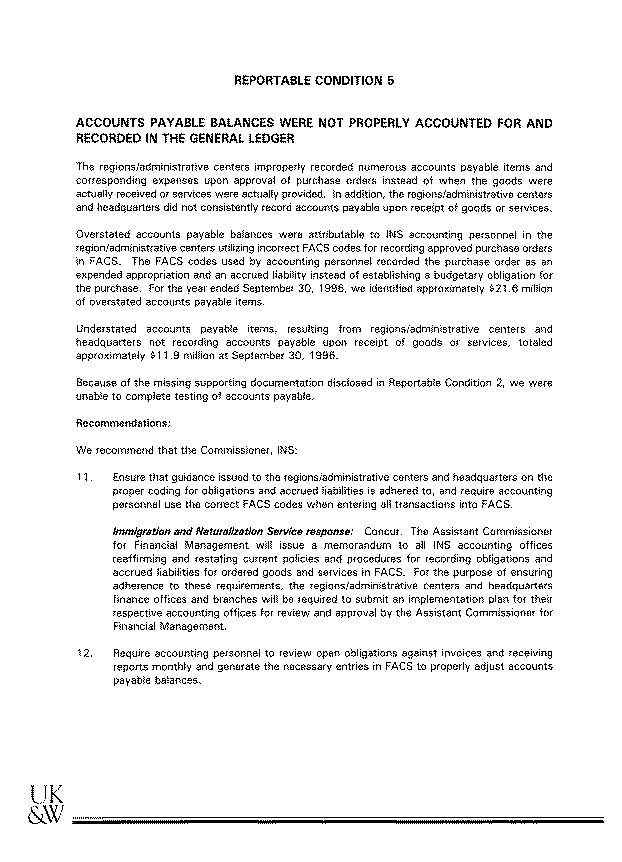
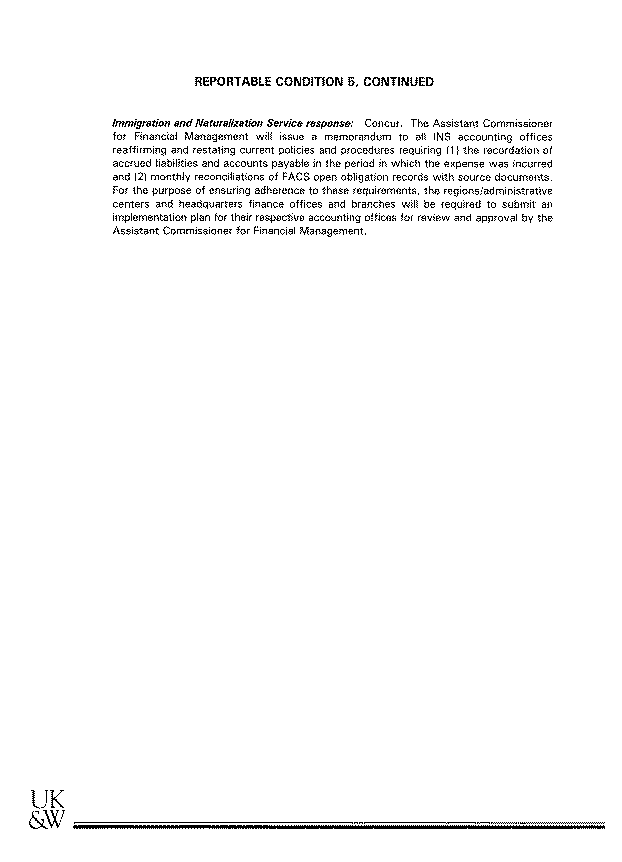
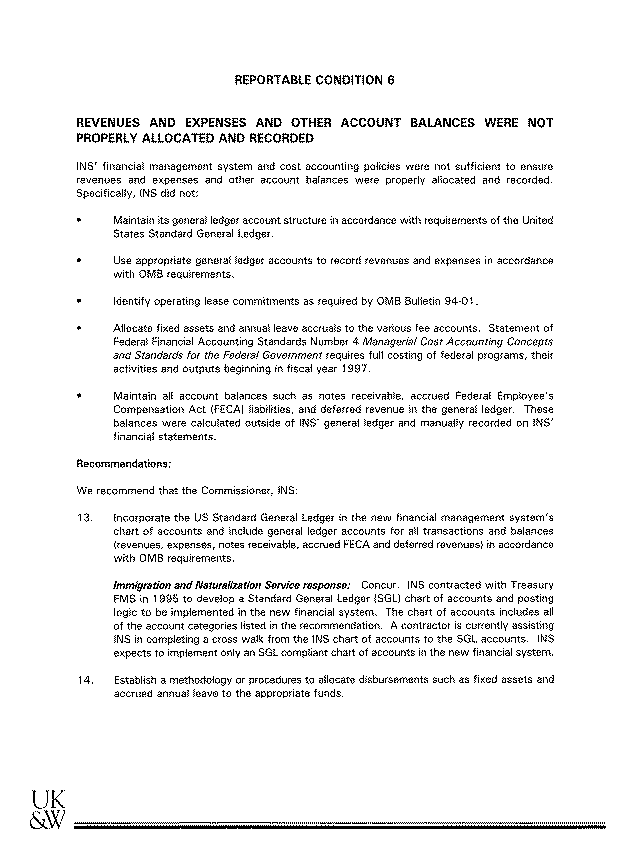
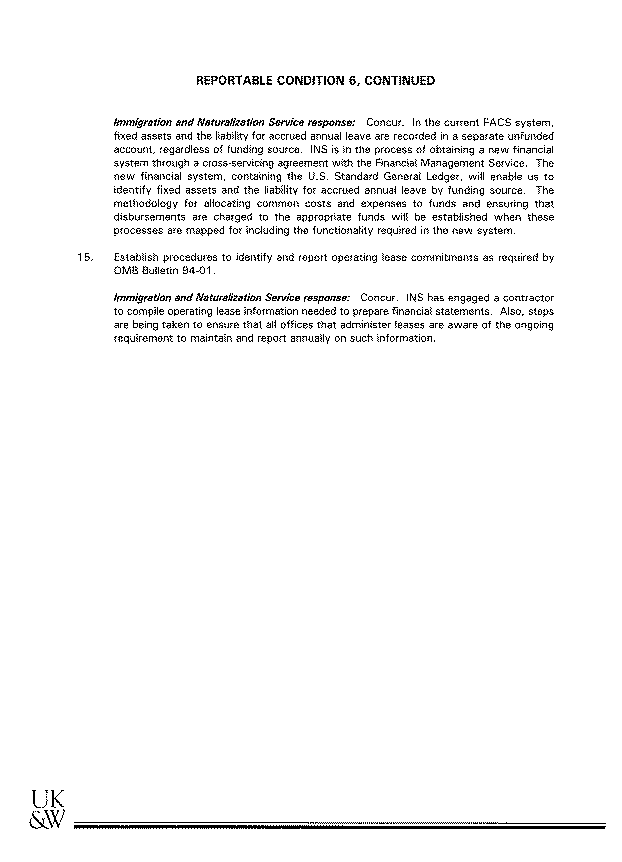
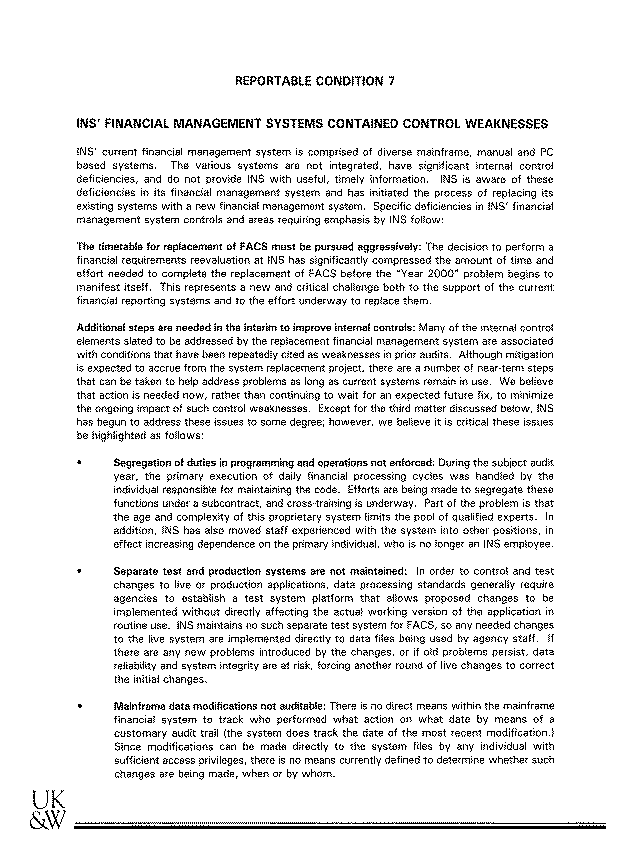
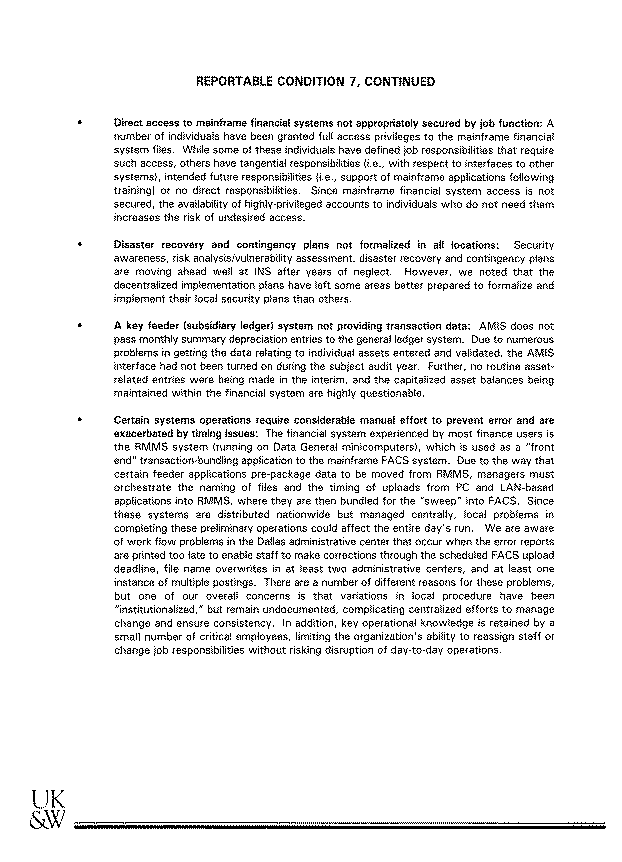
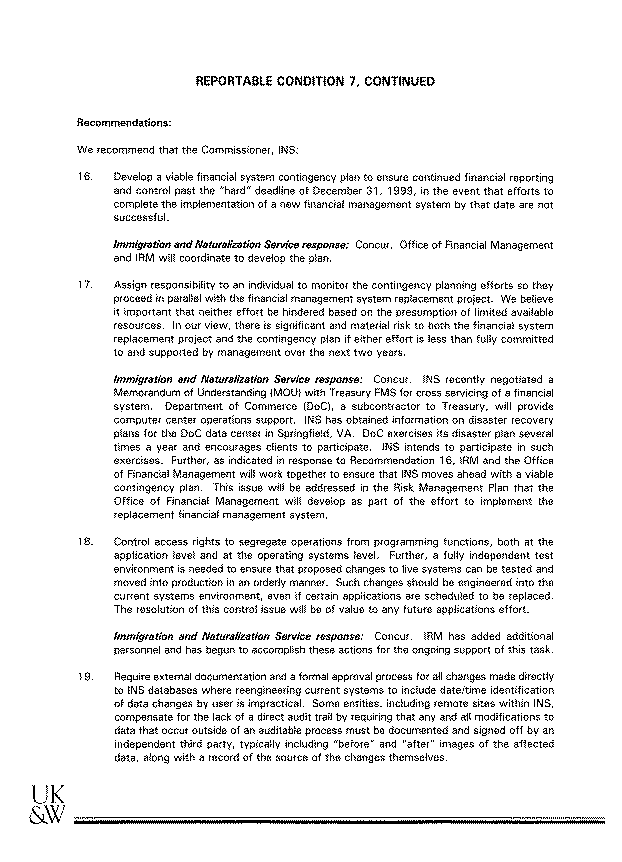
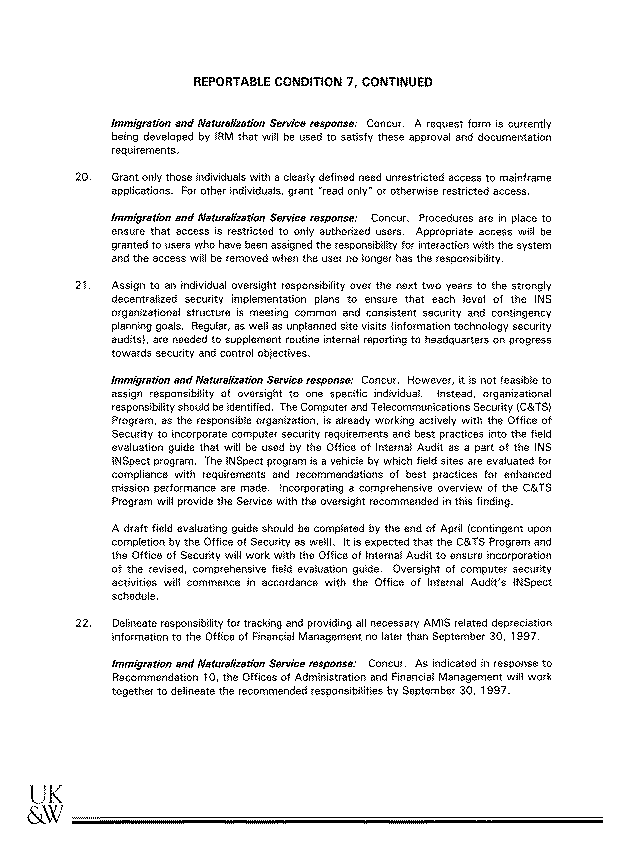
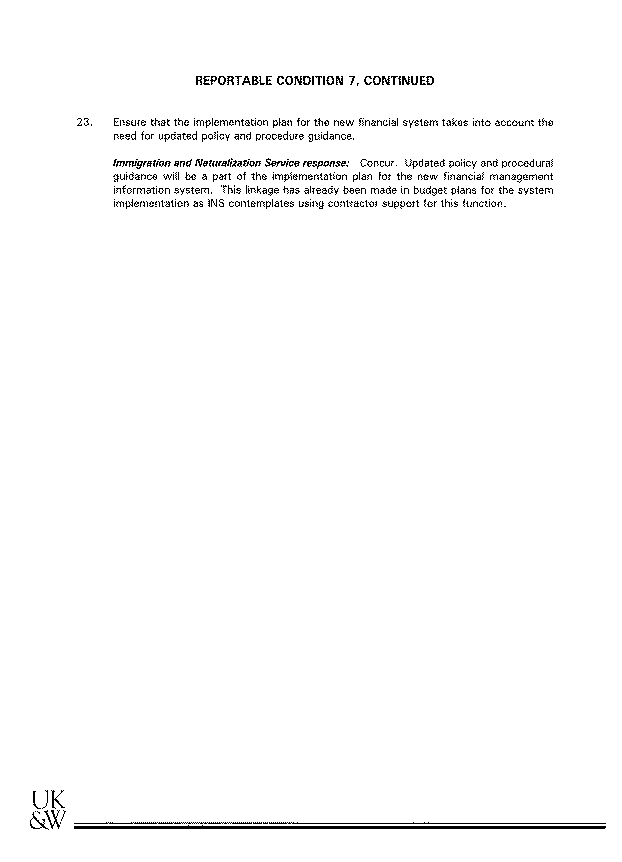
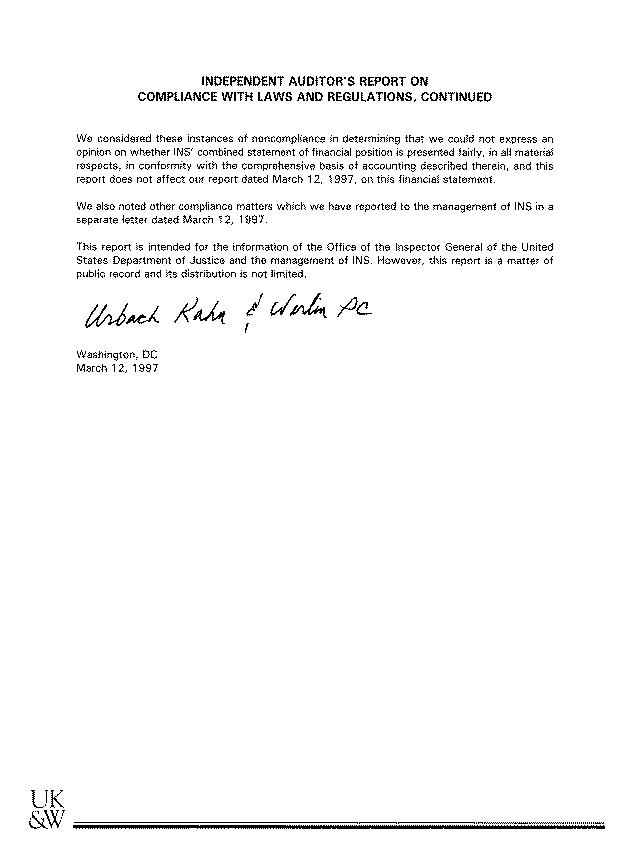
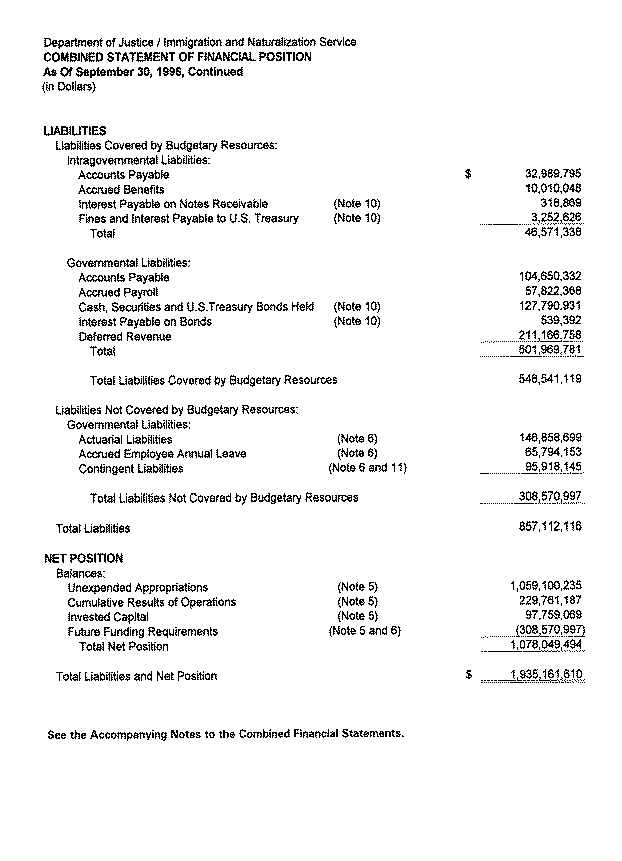
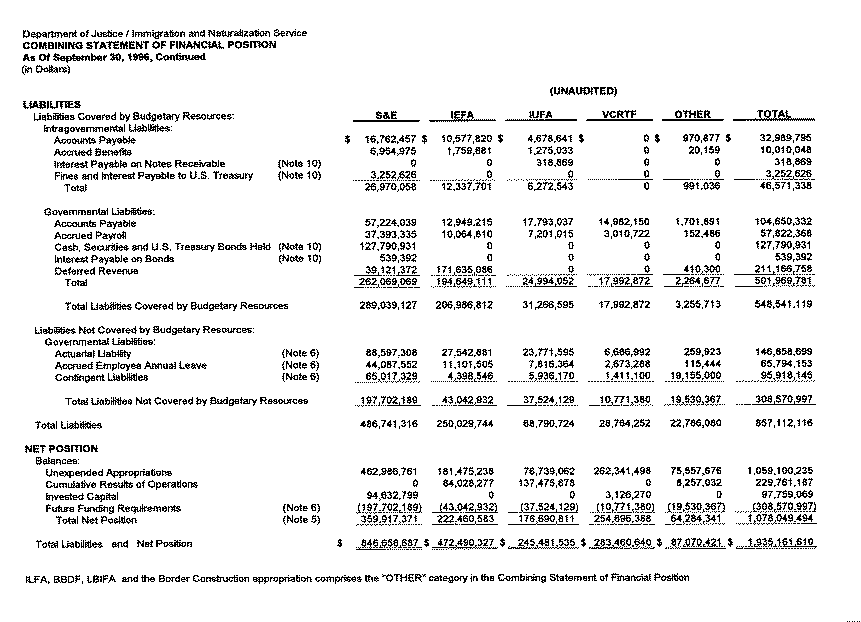
#####